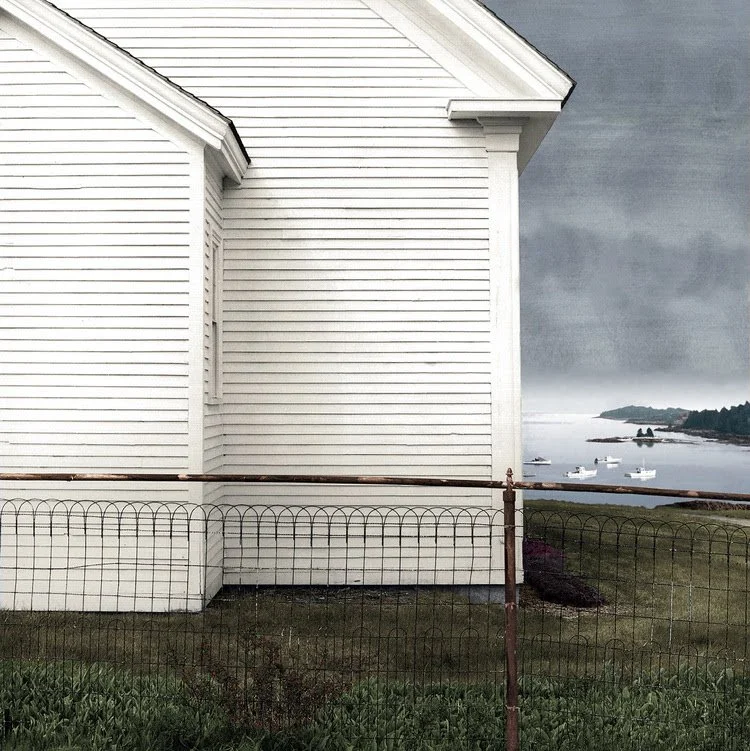
Art from a very bloody business
“Scrimshaw Utensils, Pie Crimpers and Jagging Wheels” (19th century) (whale bone), at the New Bedford Whaling Museum.
— Photo by Beth Neville
Japanese narrative screen showing a whale hunt off Wakayama.
‘The domestic sea’
“Looking West” (photomontage on aluminum) in Deer Isle, Maine, artist Jeffrey C. Becton’s show “Framing the Domestic Sea,’’ through May 5, at the New Bedford Whaling Museum.
— Image courtesy of Mr. Becton
The museum says that Maine-based Mr. Becton is inspired by the “history of New England, maritime scenes and contemporary ecological issues. His work, digital montages of coastal scenes and New England views, is printed on aluminum and evokes a surreal, dream-like quality that is simultaneously unsettling and - for those who call New England home - very familiar.’’
Sperm whales learned to avoid human killers through social communication
Picture in early edition of Herman Melville’s Moby Dick
Mother and baby sperm whales off Mauritius in the Indian Ocean
— Photo by Gabriel Barathieu
From Robert Whitcomb’s “Digital Diary,’’ in GoLocal24.com
Scientists have determined that sperm whales (think Moby Dick), under relentless attack by whalers, many from New England, in the 19th Century communicated with each other on ways to escape their killers. Whales are highly intelligent and have very well organized social cultures. We humans too often forget that we’re far from the only intelligent creatures on Earth. Indeed, we’re often not very intelligent at all
Consider this from a Royal Society report:
“Analysis of data from digitized logbooks of American whalers in the North Pacific found that the rate at which whalers succeeded in harpooning (‘striking’) sighted whales fell by about 58% over the first few years of exploitation in a region. … The initial killing of particularly vulnerable individuals would not have produced the observed rapid decline in strike rate. It appears that whales swiftly learned effective defensive behaviour. Sperm whales live in kin-based social units. Our models, show … that learned defensive measures from grouped social units with experience could lead to the documented rapid decline in strike rate. This rapid, large-scale adoption of new behaviour enlarges our concept of the spatio-temporal dynamics of non-human culture.’’
How much have the whales learned from their groups on how to avoid collisions with ships and fishing-line entanglements, or how to find new sources of food as mankind changes the ocean environment
To read more, please hit this link.
Map showing the distribution of sightings of sperm whales. Sperm whales can be found in virtually any part of the ocean not covered by ice, but are most often spotted in certain "grounds" where they like to feed or breed.
— Kurzon
In the Bourne Building of the New Bedford Whaling Museum
'Youth Voices for the Ocean'
Artworks from “Youth Voices for the Ocean,’’ at The New Bedford Whaling Museum, through Aug. 19.
This is the first part of the museum’s new “Inside Out!” outdoor exhibition series, which promotes the works inside the museum, which is now open.
Each exhibition will last two weeks and feature photographs showing a sampling of the museum's collection.
“Youth Voices for the Ocean’’ is a guest exhibit by Bow Seat Ocean Awareness Programs. Its artwork comes from more than 13,000 students across 106 countries participating in Bow Seat's annual Ocean Awareness Contest. The students were asked to show how humans are damaging the oceans, and how we can start to solve the problems we’ve caused.
'De Wind is Op!'
“Whaleship D'Vergulde Walvis” ("The Golden Whale") passing the tollhouse at Buiksloot on the IJ River, north of Amsterdam, 1759, (oil on canvas), by Johanes de Blaauw, in the Kendall Whaling Museum (Sharon, Mass.) Collection. This is in the show “De Wind is Op! Climate, Culture and Innovation in Dutch Maritime Painting,’’ through May 15 at the New Bedford Whaling Museum.
The museum says:
“The exhibition includes up to 50 paintings, prints, and other artifacts from the museum's extensive Dutch collections. ‘De Wind is Op!‘ explores the work of the Dutch and Flemish Golden Age, themed around the wind, climate, and sea.
“The Dutch were pioneers in the genre of seascape painting, and the works in the museum's collection speak to a uniquely Dutch national identity. The Dutch were shaped by the sea, prospering as a maritime superpower through the 17th Century. One in ten men in the country was at sea at any given time, resulting in a country with an intimate connection to the ocean.
“At the same time, the demand for fine art was at an all-time high as collecting became popular. This created a surge of seascapes painted with refined compositions and exquisite detail, but also with reality kept in mind. There was little need or want to embellish the ocean when it was already larger than life to Dutch culture. ‘De Wind is Op!’ offers a unique portrait of national identity and a new perspective on the ocean.’’
Tools of a brutal trade
 The University of Massachusetts at Dartmouth's gallery at 715 Purchase St., New Bedford, will present "The Harpoon Project and the Legacy of Lewis Temple'' on Jan. 29, at 6-8 p.m.
The University of Massachusetts at Dartmouth's gallery at 715 Purchase St., New Bedford, will present "The Harpoon Project and the Legacy of Lewis Temple'' on Jan. 29, at 6-8 p.m.
Mr. Temple was an African-American abolitionist and inventor. He invented the toggle harpoon in 1848 -- another way to torture whales but nice for the industry, which by that point was already in decline.
Panelists include Carl Cruz, of the New Bedford Historical Society, Michael Dyer, of the New Bedford Whaling Museum, Janine da Silva, of the New Bedford Whaling National Historical Park, and Linda Whyte Burrell, an artist. The panel will be moderated by Marc Levitt, of the "Action Speaks'', an NPR radio show based in Providence.










